

Positive Reinforcment. Negative Reinforcement. Positive Vs Negative Reinforcement - Psychestudy. Reinforcement is a fundamental concept of Operant Conditioning, whose major objective is to increase the rate of certain undesired behavior from occurring again.
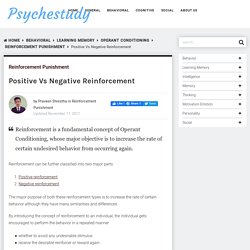
Reinforcement can be further classified into two major parts The major purpose of both these reinforcement types is to increase the rate of certain behavior although they have many similarities and differences. By introducing the concept of reinforcement to an individual, the individual gets encouraged to perform the behavior in a repeated manner whether to avoid any undesirable stimulusreceive the desirable reinforcer or reward again Differences Between Positive and Negative Reinforcement. 5 ways to manage behaviour using positive reinforcement.
When I was 5, I had a piano teacher who rapped my knuckles and told me off sternly when I didn’t practice enough.

When she asked me to be a part of her annual recital, I burst into tears and shook my head, overcome with fear at failing in front of an audience. When I was 12, I had a maths teacher who was ex-Army, who would scream at us if we asked our friends for help. He once was writing something on the board with chalk, when he heard someone whispering, and quick as an arrow, he turned and THREW that chalk at the student and hit him on the head. 4 Benefits of Positive Reinforcement in Children. Kids are constantly seeking attention, especially from their parents.
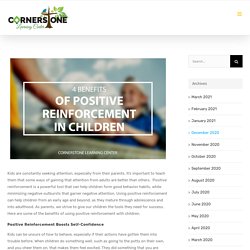
It’s important to teach them that some ways of gaining that attention from adults are better than others. Positive reinforcement is a powerful tool that can help children form good behavior habits, while minimizing negative outbursts that garner negative attention. Using positive reinforcement can help children from an early age and beyond, as they mature through adolescence and into adulthood. As parents, we strive to give our children the tools they need for success. Here are some of the benefits of using positive reinforcement with children. Negative Reinforcement and Operant Conditioning. Did you know that parents could train their children to act defiant?
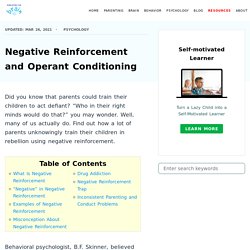
“Who in their right minds would do that?” You may wonder. Well, many of us actually do. Find out how a lot of parents unknowingly train their children in rebellion using negative reinforcement. Behavioral psychologist, B.F. What Is 'negative Reinforcement'? Definition And Real-World Examples. You've heard of negative reinforcement, but how do you put it into practice?
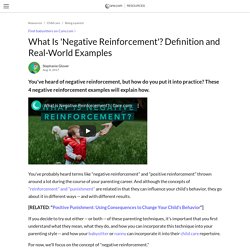
These 4 negative reinforcement examples will explain how. You've probably heard terms like "negative reinforcement" and "positive reinforcement" thrown around a lot during the course of your parenting career. And although the concepts of "reinforcement" and "punishment" are related in that they can influence your child's behavior, they go about it in different ways -- and with different results. [RELATED: "Positive Punishment: Using Consequences to Change Your Child's Behavior"] If you decide to try out either -- or both -- of these parenting techniques, it's important that you first understand what they mean, what they do, and how you can incorporate this technique into your parenting style -- and how your babysitter or nanny can incorporate it into their child care repertoire.
The power of positive re-inforcement. Development of monetary and social reward processes. Youtube. Positive Reinforcements - Tangible Rewards. Proliferating Curfew Laws Keep Kids at Home, ... Proliferating Curfew Laws Keep Kids at Home, But Fail to Curb Juvenile Crime By Angie Schwartz and Lucy Wang Laws that require adolescents to be off the streets during certain hours are an old idea that is making a strong comeback.
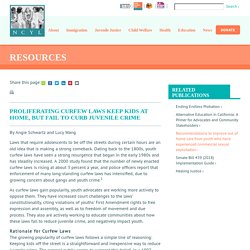
Dating back to the 1800s, youth curfew laws have seen a strong resurgence that began in the early 1980s and has steadily increased. A 2000 study found that the number of newly enacted curfew laws is rising at about 3 percent a year, and police officers report that enforcement of many long-standing curfew laws has intensified, due to growing concern about gangs and youth crime.1. Negative reinforcements - Curfew.